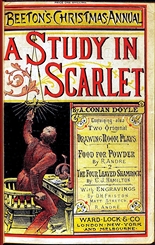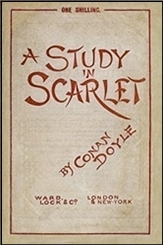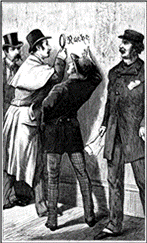Thu 7 Dec 2023
A 1001 Midnights Review: ARTHUR CONAN DOYLE – A Study in Scarlet.
Posted by Steve under 1001 Midnights , Reviews[7] Comments
by Edward D. Hoch
ARTHUR CONAN DOYLE – A Study in Scarlet. Ward, Lock & Co., July 1888. Lippincott, US, 1890. First appeared in Beeton’s Christmas Annual for 1887 (eleven copies are known to still exist). Reprinted numerous times. Adapted to radio, TV and the movies perhaps even more countless times.

The question must be asked at once: Would A Study in Scarlet be remembered and read today if there had been no other Sherlock Holmes novels or stories to follow it? Certainly it would be read, to the extent that Doyle’s White Company and Lost World are read, but it’s doubtful the book would have anything approaching its present popularity. A Study in Scarlet owes its status as a cornerstone to the fact that it introduced the world to Sherlock Holmes.
However, the book is not without merit of its own. Doyle’s clear achievement in creating the character of Sherlock Holmes,complete and full-blown, is nothing short of masterful. The case he investigates certainly has its points of interest, and the surprising arrest of the killer at the end of part one is a scene that would not be matched in mystery fiction until the equally surprising arrest at the conclusion of Ellery Queen’s Tragedy of X.

The first half of the novel deals with the meeting of Holmes and Watson, their taking rooms together in Baker Street, and Holmes’s investigation of the Lauriston Garden mystery, in which two men named Drebber and Stangerson are found murdered. each with the German word for revenge written in blood on the wall above the bodies. Holmes traps the killer at the book’s halfway point. and part two is devoted to a lengthy flashback to the early Mormon settlement of Utah, and the crimes that prompted the revenge slayings half a world away.
Though the Mormon portion of the book is interesting enough on its own. one longs to return to Holmes, and this same sort of flaw marks The Valley of Fear and to some extent The Sign of the Four. Only in The Hound of the Baskervilles is the narrative maintained without the final flashback. Still. no study of Holmes is complete without A Study in Scarlet.

Of the other novels, The Valley of Fear (1915) is far superior to The Sign of he Four (1890), in part because its flashback portion tells a fascinating story of labor unrest in the Pennsylvania coal fields of a secret society called the Scowrers, obviously patterned after the Molly Maguires. The other three short-story collections — The Return of Sherlock Holmes (1905), His Last Bow (1917), and The Case Book of Sherlock Holmes (1927) — all have their high spots, and all should be explored by the dedicated mystery reader.
———
Reprinted with permission from 1001 Midnights, edited by Bill Pronzini & Marcia Muller and published by The Battered Silicon Dispatch Box, 2007. Copyright © 1986, 2007 by the Pronzini-Muller Family Trust.
December 9th, 2023 at 12:24 am
With the exception of HOUND I’m not sure Conan Doyle quite knew what to do with Holmes at novel length or didn’t quite trust the detective element to keep readers turning the page. Again and again he falls back on long adventure story narratives to fill the book out to novel length.
Since we know Doyle was more than proficient as a novelist, I have to assume he didn’t trust the detective story to hold the reader at that length.
December 10th, 2023 at 9:24 am
I disagree. The problem is that Doyle made Holmes too smart and therefore couldn’t credibly show the character struggling to solve a mystery for the full length of a novel.
December 10th, 2023 at 2:05 pm
Aha. Makes sense. Holmes was too good as a detective to need a full novel to solve a case.
December 10th, 2023 at 4:25 pm
Not sure Boppa and David disagree: the reason Doyle didn’t trust a detective story to fill a novel was because Holmes was too quick to solve a case for it to last the length of a novel.
Even in Baskerville, Holmes didn’t show up until the half way point of the novel.
December 10th, 2023 at 5:27 pm
Ed Hoch also asked a good question in his review that I haven’t been able to answer satisfactorily, even to myself:
“Would A Study in Scarlet be remembered and read today if there had been no other Sherlock Holmes novels or stories to follow it?”
I’d like to think so, but as we’ve been discussing, it was the short stories that came afterward in which Holmes’s abilities as a detective really came into play.
December 13th, 2023 at 3:02 am
I always thought Doyle’s choice of American sub-plots strange. Mormons and Molly Maguires; eccentric American millionaires; and suchlike.
In the hypothetical question above, I feel that yes; all Doyle’s standalone novels would have been read even without a subsequent string of short stories –if –crucial ‘IF’, here –he had kept devising exotic sub-plots like the ‘fiercest tribe of the Andaman Islands’.
Poisoned-dart blowpipes and airguns and peg-legs. That kind of inventiveness.
December 14th, 2023 at 5:51 pm
Some writers are just better at writing short stories than novels. Two very different art forms. I admire writers who can write both with skill and creativity.